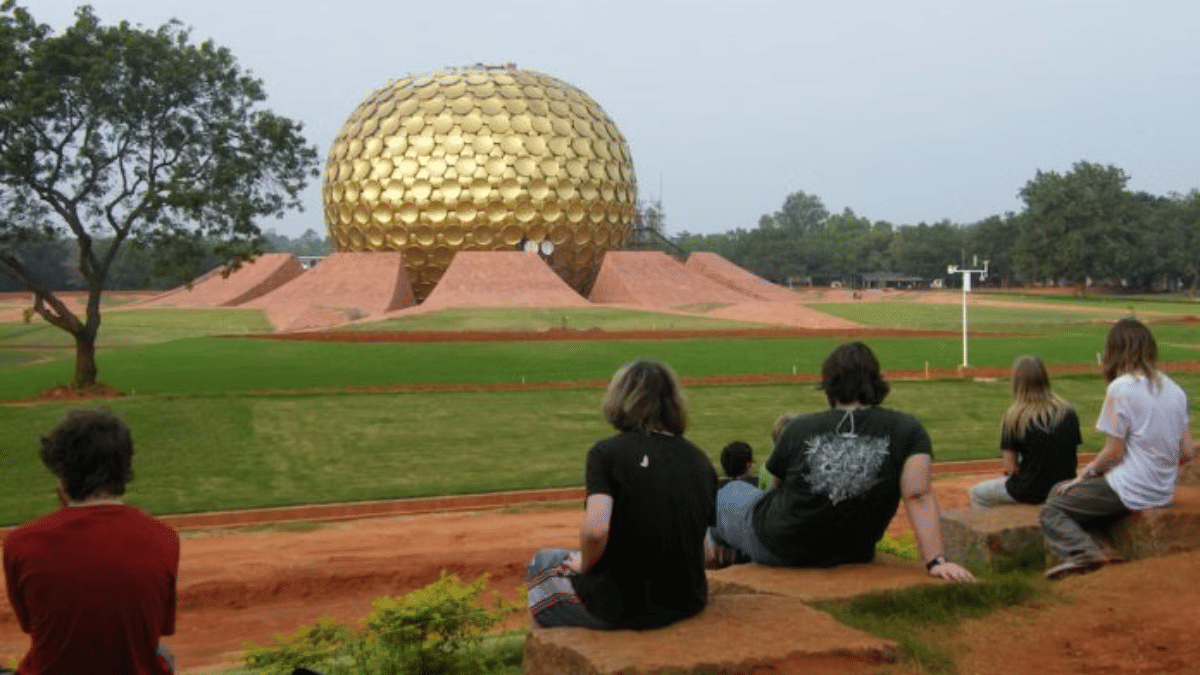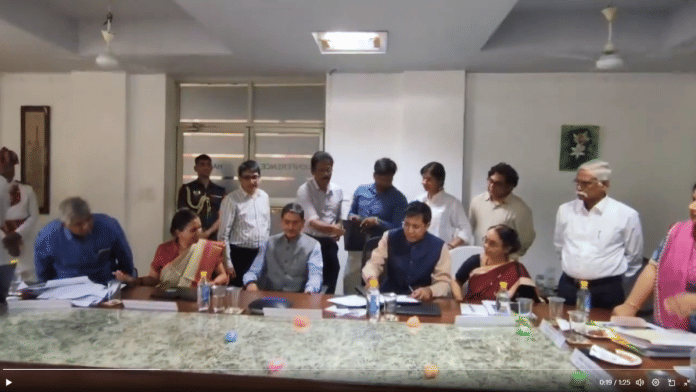New Delhi: The proposed sustainability campus of the Indian Institute of Technology Madras on a 100-acre leased land in the Auroville spiritual township in Tamil Nadu has run into a stiff opposition from a section of residents, who claim the project threatens their most productive organic farm, the Annapurna Farm.
During its 69th meeting 8 July, the Auroville Governing Board signed a memorandum of understanding (MoU) with IIT Madras to establish the campus focussed on sustainability and aimed at achieving global excellence in sustainable technologies.
The campus is proposed to be set up near the Sedarapet village, about 10 kilometers from the center of Auroville, in Tamil Nadu and will focus on sustainable solutions, including green energy technologies, electric vehicles, and innovations.
A high-level delegation from IIT Madras, led by director V. Kamakoti also visited Auroville in July to inspect the site. However, the proposed project has seen protests since the signing of the MoU, even though Auroville Working Groups, endorsed by the Auroville Governing Body, rejected the claims being made by the protesters.
A section of residents, identifying themselves as Auroville Media Liaison or a subgroup of the Working Committee of the Residents’ Assembly, issued a statement 15 August, calling the campus move a “violation of Auroville’s founding principles”. The statement alleged the commitment to establish a campus was made without any consultation with the community.
They claim the proposed 100-acre site for campus is where the Annapurna Farm exists and the project would destroy the Auroville community’s central granary. They are demanding reconsideration of the site for the campus.
Additionally, an online petition titled ‘Save Annapurna Farm from IIT Campus Conversion’ was launched 16 August. It had gathered over 2,700 signatures by Tuesday.
In a statement issued to ThePrint, the Working Groups of Auroville issued a point-by-point rebuttal to the claims being made by protesters.
It said the protesters’ claims about the project—“destroying Auroville’s most productive farm”, “EV truck test track on farm fields”, and “loss of food self-sufficiency”—are either incorrect or speculative.
The Working Groups—which includes residents, the Auroville Town Development Council (ATDC), the Funds & Assets Management Committee (FAMC), and the Auroville Farm Service— said a body styling itself as the ‘Auroville Media Liaison’ has been circulating anonymous bulletins.
The Auroville Media Liaison is not an authorised entity of the Auroville Foundation, the statement said.
“IIT planning of the campus will include attention to environmental standards, infrastructure responsibilities, community benefits (education and skilling pipelines), and compatibility with Auroville’s development objectives,” the statement said.
On its website, Auroville, set up in 1968, calls itself a ‘City of Dawn’. It says it wants to be a universal town where men and women of all countries are able to live in peace and progressive harmony above all creeds, all politics and all nationalities. “The purpose of Auroville is to realise human unity,” it says.
Auroville on residents’ apprehensions
According to the sub-group of the Working Committee of the Residents’ Assembly or Auroville Media Liaison, the Annapurna Farm produces 30 percent of Auroville’s food supply and processes over 90 percent of grains from other farms in the township. They called it the community’s central granary.
“While some farming activities took place in the 1970s, the current Annapurna Farm was established in the early 1980s and has since become a model of regenerative agriculture across its 135 acres, holding IMO Control (central certification for organic farming) organic certification since 2005,” they said in their statement.
They rejected the claim that the farm uses only 35 acres of land for cultivation, arguing that organic farming depends on a broader ecosystem that includes “20 acres of paddy, 25 acres of fodder, 30 acres of animal grazing, 38 acres of forest buffers” as well as infrastructure like cowsheds, compost areas, and processing units.

In response, the Working Groups of Auroville stated that Annapurna’s effective cultivation area is approximately 30 acres, and that Auroville’s total farm output (not just Annapurna’s) meets less than 12 percent of its current food needs. They added that food security can be improved by consolidating production within the green belt and upgrading those farms.
“Annapurna farm was certainly not feeding 10% – 20% of Auroville’s current population but contributed to a mere fraction of Auroville’s food needs,” it added.
The Auroville Media Liaison raised concerns over the inclusion of an electric-powered truck testing track in the proposed campus, saying it would “destroy productive farmland to test heavy vehicles”. They also raised concerns over the job losses of people working on Annapurna.
However, the Working Groups of Auroville said there are no approved plans that exist for a truck test track at Annapurna. “All current residents, newcomers and volunteers at Annapurna will transition to Green Belt farms; campus development and operations will increase local opportunities over time,” they said, adding their roles will be matched.
They said the claims that the farm cannot be relocated and it needs all 135 acres are baseless. “Annapurna’s constraints (soil-water-inputs) limit scalable diversification. 35 acres of land is adequate for retained functions while core food production shifts to the green belt.”
The Working Groups noted in the statement that recent balance sheets show sustained operating losses and modest production for a site of over 100 acres. “The balance sheets show that the farm runs on consistent losses, and sustains itself on donations, in the best of cases. This is the very evidence of a poorly running farm which is instead being inflated in the media today as a food bank for Auroville.”
The Auroville Media Liaison also alleged a lack of transparency in the entire process. “The text of the MoU has never been shared with the Auroville Community despite several requests, including through RTIs,” they claimed, also adding local experts had not been consulted and no environmental impact study had been done.
However, the Working Groups of Auroville denied the claims of the community being excluded. They said their group, which consists of a large majority of residents, endorsed the decision of the Governing Board. They also said the relevant documents will be made public when ready.
While urging IIT Madras to reconsider the proposed location and work with the community to find alternatives that do not “sacrifice” decades of ecological restoration in the name of sustainability, the Auroville Media Liaison also called on the authorities, including the Governing Board, to immediately “reverse the decision” and engage in a genuine consultation with residents.
ThePrint reached IIT Madras seeking a comment. The report will be updated if and when a response is received.
The online petition
Along with the protests, an online petition was also launched 16 August by vocalist and guitarist Kirtana Krishna, who is associated with Auroville.
“The land of Annapurna Farm is more than just soil and crops — it’s the very lifeline of our community. The acres of fertile land are at risk of being snatched away for the development of an IIT campus, threatening not only the welfare of our farmers but also the food security of the entire Auroville region,” the petition states.
It says the Annapurna Farm has, for generations, sustained Auroville with the nutritious and organic produce that graces our tables. “The proposal to transfer over 100 acres of this thriving farmland for an academic institution poses an existential threat to our community’s sustainable living. This isn’t just a local issue; it sets a dangerous precedent for land allocations favoring development over sustainability.”
Michel Danino, a scholar on Indian civilisation who has been closely associated with Auroville since the 1970s, is among the petition’s signatories. He also expressed his opposition to the proposed project.
“The IIT Madras project surely has its own merits, but establishing a ‘sustainability campus’ after destroying 100 acres of this model farm is irrational, unscientific and counterproductive,” Danino wrote in a LinkedIn post.
“I hope the IIT Madras administration and faculty will realize this and step back; it should be quite possible to find 100 acres of wasteland elsewhere, which IIT Madras could develop into a rich environment, instead of the opposite process that is being contemplated.”
However, the working committee states that the Governing Board has decided to collaborate with IIT for the future of Auroville’s youth.
“The IIT collaboration will bring labs, scholarships, internships, skilling, and jobs, innovation and a shift into a creative learning culture and cutting-edge technology, acting as a regional economic multiplier for Auroville’s youth and surrounding villages,” they said.
(Edited by Ajeet Tiwari)
Also Read: IIT-M director has a piece of advice for investors—play the long game, deep-tech needs time






